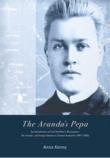AustLit
 3590808624348196877.jpg
3590808624348196877.jpg
 The Aranda’s Pepa : An Introduction to Carl Strehlow's Masterpiece, Die Aranda-und Loritja-Stamme in Zentral-Australien (1907-1920)
single work
The Aranda’s Pepa : An Introduction to Carl Strehlow's Masterpiece, Die Aranda-und Loritja-Stamme in Zentral-Australien (1907-1920)
single work
Latest Issues
AbstractHistoryArchive Description
'The German missionary Carl Strehlow (1871–1922) had a deep ethnographic interest in Aboriginal Australian cosmology and social life, which he documented in his 7-volume work Die Aranda- und Loritja-Stämme in Zentral-Australien that remains unpublished in English. In 1913, Marcel Mauss called his collection of sacred songs and myths an Australian Rig Veda. This immensely rich corpus, based on a lifetime on the central Australian frontier, is barely known in the English-speaking world and is the last great body of early Australian ethnography that has not yet been built into the world of Australian anthropology and its intellectual history.'
'The German psychological and hermeneutic traditions of anthropology that developed outside of a British–Australian intellectual world were alternatives to 19th-century British scientism. The intellectual roots of early German anthropology reached back to Johann Gottfried Herder (1744–1803), the founder of German historical particularism, who rejected the concept of race as well as the French dogma of the uniform development of civilisation. Instead, he recognised unique sets of values transmitted through history and maintained that cultures had to be viewed in terms of their own development and purpose. Thus, humanity was made up of a great diversity of ways of life, language being one of its main manifestations. It is this tradition that led to a concept of cultures in the plural.' (Source: Publisher's website)
Publication Details of Only Known VersionEarliest 2 Known Versions of
Works about this Work
-
The Aranda’s Pepa: An Introduction to Carl Strehlow’s Masterpiece, Die Aranda-und Loritja - Stamme in Zentral Australien (1907–1920) : Review
2015
single work
review
— Appears in: Aboriginal History , December vol. 39 no. 2015; (p. 255-258)
— Review of The Aranda’s Pepa : An Introduction to Carl Strehlow's Masterpiece, Die Aranda-und Loritja-Stamme in Zentral-Australien (1907-1920) 2013 single work non-fiction -
[Review Essay] You Have Full Text Access to This ContentThe Aranda's Pepa: An Introduction to Carl Strehlow's Masterpiece Die Aranda Und Loritja-Stämme in Zentral Australien (1907–1920)
2015
single work
essay
— Appears in: Oceania , July vol. 85 no. 2 2015; (p. 246-247)'Of all the celebrated anthropological classics penned about Australian Aborigines, Carl Strehlow's Die Aranda- und Loritja-Stämme in Zentral Australien is probably the most paradoxical, for it is at once famous and obscure. In her preface to The Aranda's Pepa, Kenny (xv) informs us that Marcel Mauss referred to Strehlow's early volumes as ‘a kind of Australian Rig Veda’. The work was also cited by Durkheim, Lang, Lévi-Strauss, and others, and continues to be regarded as integral to the corpus of ethnographic material that any scholar of Central Australia needs to cover. Kenny describes the five volumes (seven parts) of the work, published in German between 1907 and 1920, as Strehlow's ‘magnum opus’ and as ‘a masterpiece of classical Australian anthropology’ (1), yet underlines the fact that, astonishingly, it has never been republished, either in its original German or in either of the two English translations that have sat quietly and largely immobile in Australian libraries – in one case since the 1930s, in the other since the 1990s. Hence, while many anthropologists know of Carl Strehlow's writing, few Anglophone scholars know it in the round.' (Introduction)
-
The Aranda’s Pepa: An Introduction to Carl Strehlow’s Masterpiece, Die Aranda-und Loritja - Stamme in Zentral Australien (1907–1920) : Review
2015
single work
review
— Appears in: Aboriginal History , December vol. 39 no. 2015; (p. 255-258)
— Review of The Aranda’s Pepa : An Introduction to Carl Strehlow's Masterpiece, Die Aranda-und Loritja-Stamme in Zentral-Australien (1907-1920) 2013 single work non-fiction -
[Review Essay] You Have Full Text Access to This ContentThe Aranda's Pepa: An Introduction to Carl Strehlow's Masterpiece Die Aranda Und Loritja-Stämme in Zentral Australien (1907–1920)
2015
single work
essay
— Appears in: Oceania , July vol. 85 no. 2 2015; (p. 246-247)'Of all the celebrated anthropological classics penned about Australian Aborigines, Carl Strehlow's Die Aranda- und Loritja-Stämme in Zentral Australien is probably the most paradoxical, for it is at once famous and obscure. In her preface to The Aranda's Pepa, Kenny (xv) informs us that Marcel Mauss referred to Strehlow's early volumes as ‘a kind of Australian Rig Veda’. The work was also cited by Durkheim, Lang, Lévi-Strauss, and others, and continues to be regarded as integral to the corpus of ethnographic material that any scholar of Central Australia needs to cover. Kenny describes the five volumes (seven parts) of the work, published in German between 1907 and 1920, as Strehlow's ‘magnum opus’ and as ‘a masterpiece of classical Australian anthropology’ (1), yet underlines the fact that, astonishingly, it has never been republished, either in its original German or in either of the two English translations that have sat quietly and largely immobile in Australian libraries – in one case since the 1930s, in the other since the 1990s. Hence, while many anthropologists know of Carl Strehlow's writing, few Anglophone scholars know it in the round.' (Introduction)
- Die Aranda-und Loritja-Stamme in Zentral-Australien 1907 single work non-fiction criticism


